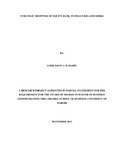| dc.description.abstract | Prior studies have found that failure to detect fraudulent financial reporting can expose the auditor to adverse legal and/or regulatory consequences. Most of them are on international scenes or on developed countries. At the time of the study, no local or international studies had ever focused on the strategic responses adopted by banks in Kenya to counter increasing fraud risks. This was despite the ever increasing cases of fraud risks that had claimed a number of financial institutions in Kenya and thus calling for strategic responses to curb the spread of the crime. The study generally sought to determine the responses by Equity Bank to fraud related risks in the banking industry.
This was a case study since the unit of analysis was one organisation aimed at getting detailed information regarding the strategic responses to increasing fraud related risks at Equity Bank of Kenya Limited. Primary data was collected using an interview guide. The interview guide contained open-ended questions. The open-ended questions enabled the researcher to collect qualitative data. Before processing the responses, the completed interview guide was edited for completeness and consistency. A content analysis was employed. The content analysis was used to analyze the interviewees' views about the strategic responses to fraud risk in Equity Bank. The information was presented in a continuous prose. 18 out of the 20 interviewees targeted completed the interview guide making a response rate of87.5%.
The study concludes that fraud is very sensitive and that customers have immense fear of fraud and it impacts negatively on banks profitability where income lost through fraud would have been reinvested to foster growth. Higher profits for a business will indicate that a Bank management is having the right strategy thus sending a positive signal to the market. The study also concludes that the worst fraud risk is identity theft where identification documents are easy to reproduce, fraudsters make parallel passports, IDs and driving licenses then use them to take over accounts. The study further concludes that cheque fraud is a common type of fraud mainly because customers with cheque books are not careful in ensuring that their books are kept in safe custody. The Bank's IT infrastructure is designed to support the monitoring process by producing daily reports and alerts to be actioned. The study also revealed that a whistle blowing facility is existent in the Bank.
The study recommends that there should be reforms in the police. This could help reduce the fraud related risks in the bank. The recommends that since the judiciary is a key player in Fraud Management and that over the time, it has been seen that courts often acquit or hand in lenient sentences to deadly fraudsters, the judiciary needs to be empowered through reform to be able to understand and be of help. The study also recommends that review of Fraud Legislation could reduce fraud related risks in the banks. Kenya still lags behind on anti fraud laws. The study also recommends that review of security features of security documents (The Kenyan National ID, Driving licenses, passports and Title deeds) would also eliminate fraud related risks in the bank. Other recommendations suggested include staff Management where staff need constant monitoring and motivation of staffs. Appropriate methods should be put in place to deal with the situations. Methods such as employee screening, staff account monitoring, profiling of staff disciplinary cases, job rotation and enrichment are worth considering. | en_US |

